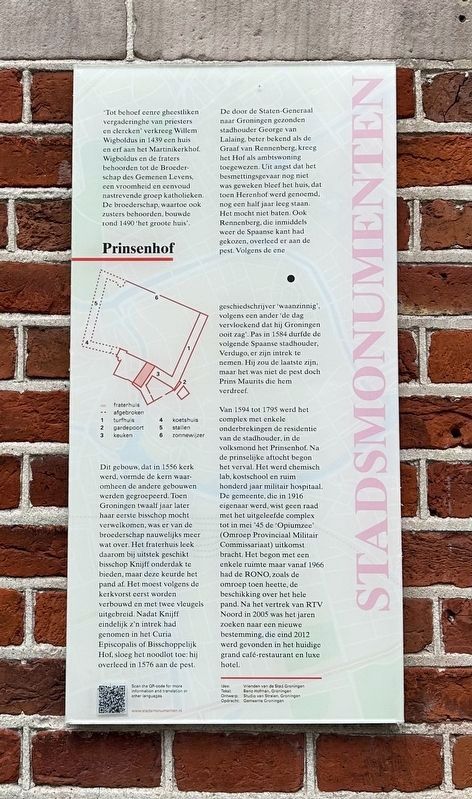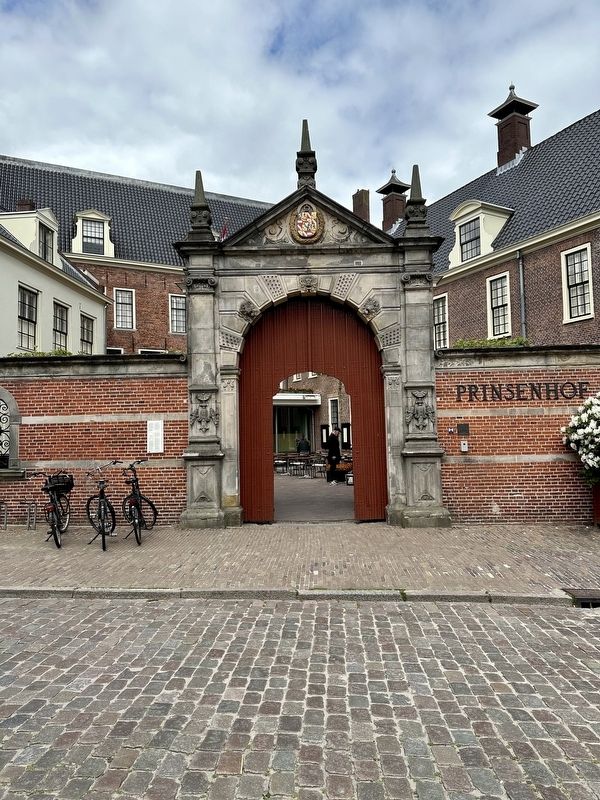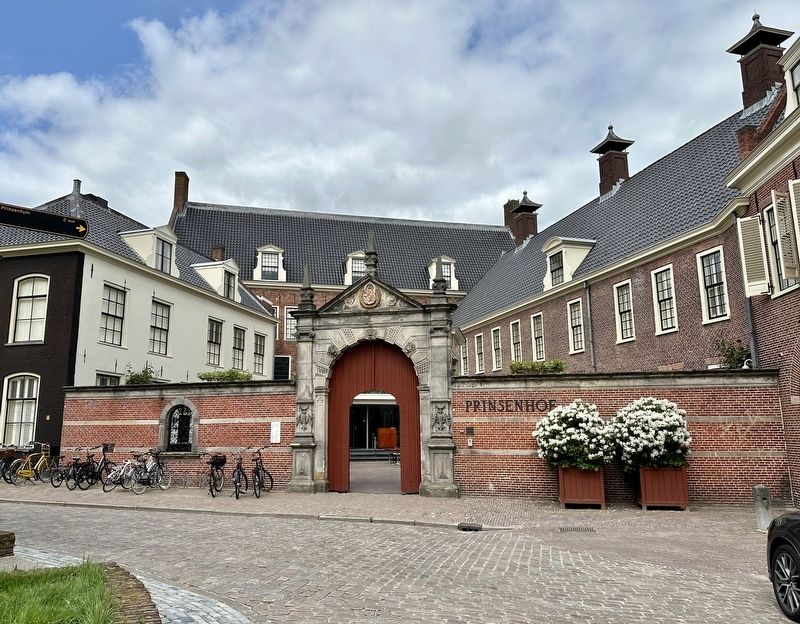Groningen, Netherlands — Northwestern Europe
Prinsenhof
— Stadsmonumenten —
Dit gebouw, dat in 1556 kerk werd, vormde de kern waaromheen de andere gebouwen werden gegroepeerd. Toen Groningen twaalf jaar later haar eerste bisschop mocht verwelkomen, was er van de broederschap nauwelijks meer wat over. Het fraterhuis leek daarom bij uitstek geschikt bisschop Knijff onderdak te bieden, maar deze keurde het pand af. Het moest volgens de kerkvorst eerst worden verbouwd en met twee vleugels uitgebreid. Nadat Knijff eindelijk z’n intrek had genomen in het Curia Episcopalis of Bisschoppelijk Hof, sloeg het noodlot toe: hij overleed in 1576 aan de pest.
De door de Staten-Generaal naar Groningen gezonden stadhouder George van Lalaing, beter bekend als de Graaf van Rennenberg, kreeg het Hof als ambtswoning toegewezen. Uit angst dat het besmettingsgevaar nog niet was geweken bleef het huis, dat toen Herenhof werd genoemd, nog een half jaar leeg staan. Het mocht niet baten. Ook Rennenberg, die inmiddels weer de Spaanse kant had gekozen, overleed er aan de pest. Volgens de ene geschiedschrijver ‘waanzinnig’, volgens een ander ‘de dag vervloekend dat hij Groningen ooit zag’. Pas in 1584 durfde de volgende Spaanse stadhouder, Verdugo, er zijn intrek te nemen. Hij zou de laatste zijn, maar het was niet de pest doch Prins Maurits die hem verdreef.
Van 1594 tot 1795 werd het complex met enkele onderbrekingen de residentie van de stadhouder, in de volksmond het Prinsenhof. Na de prinselijke aftocht begon het verval. Het werd chemisch lab, kostschool en ruim honderd jaar militair hospitaal. De gemeente, die in 1916 eigenaar werd, wist geen raad met het uitgeleefde complex tot in mei ’45 de ‘Opiumzee’ (Omroep Provinciaal Militair Commissariaat) uitkomst bracht. Het begon met een enkele ruimte maar vanaf 1966 had de RONO, zoals de omroep toen heette, de beschikking over het hele pand. Na het vertrek van RTV Noord in 2005 was het jaren zoeken naar een nieuwe bestemming, die eind 2012 werd gevonden in het huidige grand café-restaurant en luxe hotel.
“At a spiritual meeting of priests and clerks”, Willem Wigboldus hold of a house and yard at the Martinikerkhof in 1439. Wigboldus and the friars belonged to the “Brotherhood of common living”, a pious and an austere group of Catholics. The fellowship, to which also sisters belonged to, built ‘the big house’ around 1490.
This building, which became a church in 1556, formed the heart of other buildings which were built around it. Twelve years later, when the first bishop was welcomed in Groningen, there was almost nothing left of the fellowship. The friar house seemed therefore utterly appropriate for the bishop Knijff to serve as accommodation, but they disapproved it. According to the church sovereign, it first had to be renovated and expanded with two wings. After that, Knijff finally settled in the ‘Curia Episcopalis of Bishop Court’, he got stricken by fate: he passed away because of the pestilence in 1576.
The regent George van Lalaing who was sent by means of the States General to Groningen, well-known as the Earl of Rennenberg, got the Court assigned as office residence. Out of fear that the contamination danger hadn’t disappeared out of the house yet, which was called “Herenhof” at the time, the house stayed empty for another half year. It was in vain. Also, Rennenberg, who in the meanwhile again chose for the Spanish side, died from the pestilence. According to one historian, he was “insane”, while other historians believe “cursed is the day when he ever saw Groningen”. Only in 1584 the new Spanish regent, Verdugo, dared to inhabit the Court. He would be the last one, but it was not the pestilence nor Prince Maurits who expelled him.
From 1594 to 1795 the complex became with some interruptions the residence of the regent, in vernacular the “Prinsenhof”. After the princely retreat, the deterioration began. It became a chemical lab, boarding-school and for around hundred years it was a military hospital. The municipality, which became the complex’s new owner in 1916, was at an utter loss with the worn out complex till in May ’45 the “Opiumzee” (Omroep Provinciaal Militair Commissariaat) came with a solution. It started with a singular space, but from 1966 the RONO, as the broadcasting radio then was called, had the whole building at its disposal. After the departure of RTV Noord in 2005, they have been looking for years for a new destination, which at the end of 2012 was found in the current Grand Café-Restaurant and luxury hotel.
Erected by Gemeente Groningen. (Marker Number 040.)
Topics and series. This historical marker is listed in these topic lists: Churches & Religion • Government & Politics • Industry & Commerce • Science & Medicine. In addition, it is included in the Groningen Stadsmonumenten series list. A significant historical year for this entry is 1439.
Location. 53° 13.243′ N, 6° 34.147′ E. Marker is in Groningen. Marker is on Martinikerkhof, on the right when traveling west. Touch for map. Marker is at or near this postal address: Martinikerkhof 23, Groningen 9712 HX, Netherlands. Touch for directions.
Other nearby markers. At least 8 other markers are within walking distance of this marker. St. Walburgstraat 1 (within shouting distance of this marker); Provinciehuis / Provincial House (about 150 meters away, measured in a direct line); Martinitoren / St. Martin Tower (about 150 meters away); Martinikerk / St. Martin Church (about 150 meters away); Feithhuis (about 180 meters away); Oude Ebbingstraat 39 (about 180 meters away); De bevrijding van Groningen / The Liberation of Groningen Memorial (approx. 0.3 kilometers away); De Drie Gezusters / The Three Sisters (approx. 0.3 kilometers away). Touch for a list and map of all markers in Groningen.
Also see . . . History (Prinsenhof Groningen Hotel). The hotel presents a history of the complex…
Excerpt: The Groninger Monumentenfonds (Groningen Monumental Fund) described Prinsenhof as one of the most beautiful buildings in the city of Groningen, and we couldn’t agree more. ‘There are very few buildings that tell so much about the city’s history as this monument’, said to Dick Janssen, former director of the Groningen Monumental Fund.(Submitted on June 5, 2023.)
The building’s origin lies with the Brethren of Communal Life, who lived here rather modestly around 1436 and rebuilt their home to an impressive church in which the brasserie is situated. Where used to be the church’s nave, is now a bar; where used to be the chancel, is now an elevated lounge. The ancient bricks along the sides of the brasserie still show traces of the old Crosse
Credits. This page was last revised on December 31, 2023. It was originally submitted on June 5, 2023, by Andrew Ruppenstein of Lamorinda, California. This page has been viewed 57 times since then and 11 times this year. Photos: 1, 2, 3. submitted on June 5, 2023, by Andrew Ruppenstein of Lamorinda, California.


